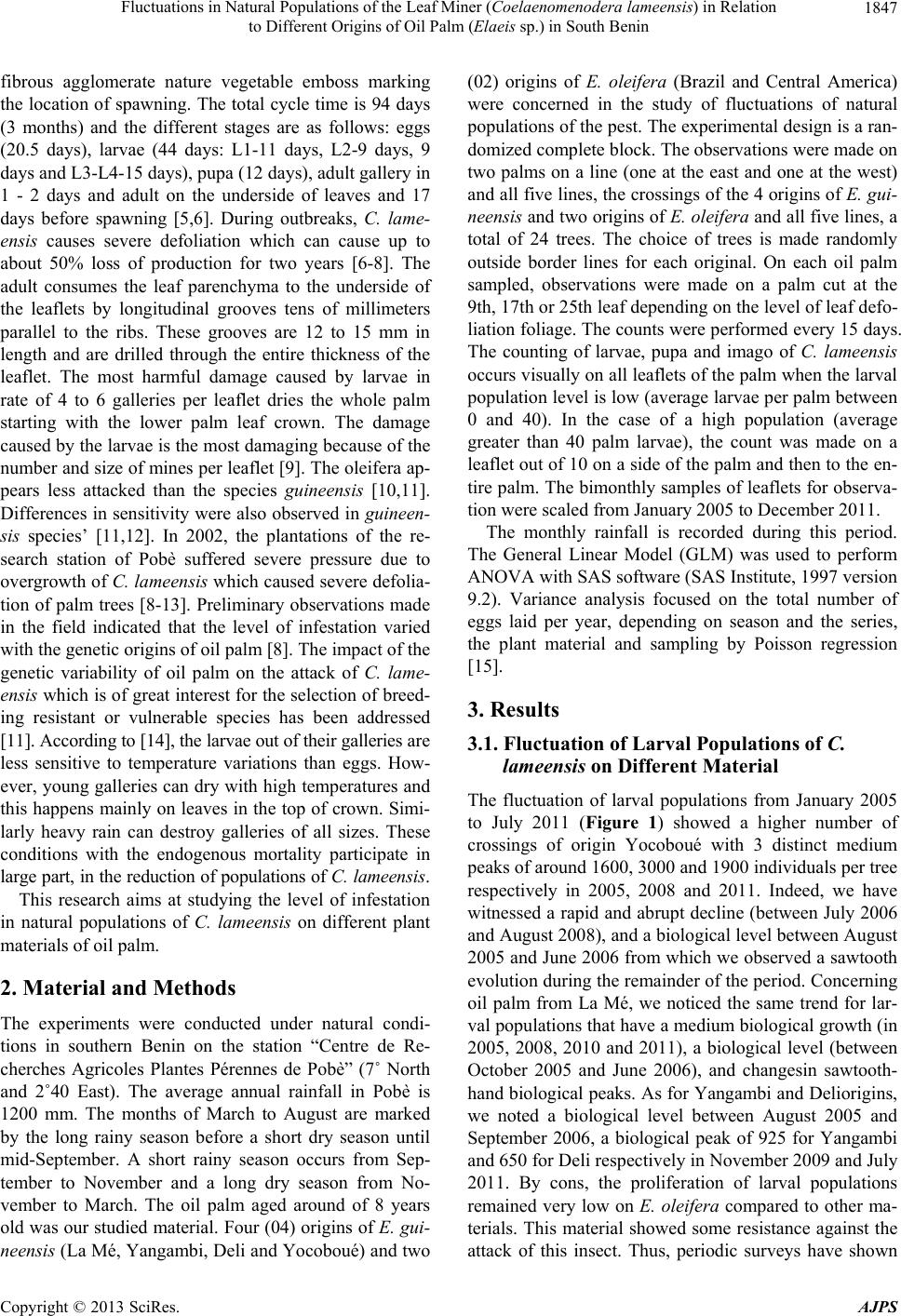
Fluctuations in Natural Populations of the Leaf Miner (Coelaenomenodera lameensis) in Relation
to Different Origins of Oil Palm (Elaeis sp.) in South Benin
1847
fibrous agglomerate nature vegetable emboss marking
the location of spawning. The total cycle time is 94 days
(3 months) and the different stages are as follows: eggs
(20.5 days), larvae (44 days: L1-11 days, L2-9 days, 9
days and L3-L4-15 days), pupa (12 days), adult gallery in
1 - 2 days and adult on the underside of leaves and 17
days before spawning [5,6]. During outbreaks, C. lame-
ensis causes severe defoliation which can cause up to
about 50% loss of production for two years [6-8]. The
adult consumes the leaf parenchyma to the underside of
the leaflets by longitudinal grooves tens of millimeters
parallel to the ribs. These grooves are 12 to 15 mm in
length and are drilled through the entire thickness of the
leaflet. The most harmful damage caused by larvae in
rate of 4 to 6 galleries per leaflet dries the whole palm
starting with the lower palm leaf crown. The damage
caused by the larvae is the most damaging because of the
number and size of mines per leaflet [9]. The oleifera ap-
pears less attacked than the species guineensis [10,11].
Differences in sensitivity were also observed in guineen-
sis species’ [11,12]. In 2002, the plantations of the re-
search station of Pobè suffered severe pressure due to
overgrowth of C. lameensis which caused severe defolia-
tion of palm trees [8-13]. Preliminary observations made
in the field indicated that the level of infestation varied
with the genetic origins of oil palm [8]. The impact of the
genetic variability of oil palm on the attack of C. lame-
ensis which is of great interest for the selection of breed-
ing resistant or vulnerable species has been addressed
[11]. According to [14], the larvae out of their galleries are
less sensitive to temperature variations than eggs. How-
ever, young galleries can dry with high temperatures and
this happens mainly on leaves in the top of crown. Simi-
larly heavy rain can destroy galleries of all sizes. These
conditions with the endogenous mortality participate in
large part, in the reduction of populations of C. lameensis .
This research aims at studying the level of infestation
in natural populations of C. lameensis on different plant
materials of oil palm.
2. Material and Methods
The experiments were conducted under natural condi-
tions in southern Benin on the station “Centre de Re-
cherches Agricoles Plantes Pérennes de Pobè” (7˚ North
and 2˚40 East). The average annual rainfall in Pobè is
1200 mm. The months of March to August are marked
by the long rainy season before a short dry season until
mid-September. A short rainy season occurs from Sep-
tember to November and a long dry season from No-
vember to March. The oil palm aged around of 8 years
old was our studied material. Four (04) origins of E. gui-
neensis (La Mé, Yangambi, Deli and Yocoboué) and two
(02) origins of E. oleifera (Brazil and Central America)
were concerned in the study of fluctuations of natural
populations of the pest. The experimental design is a ran-
domized complete block. The observations were made on
two palms on a line (one at the east and one at the west)
and all five lines, the crossings of the 4 origins of E. gui-
neensis and two origins of E. oleifera and all five lines, a
total of 24 trees. The choice of trees is made randomly
outside border lines for each original. On each oil palm
sampled, observations were made on a palm cut at the
9th, 17th or 25th leaf depending on the level of leaf defo-
liation foliage. The counts were performed every 15 days.
The counting of larvae, pupa and imago of C. lameensis
occurs visually on all leaflets of the palm when the larval
population level is low (average larvae per palm between
0 and 40). In the case of a high population (average
greater than 40 palm larvae), the count was made on a
leaflet out of 10 on a side of the palm and then to the en-
tire palm. The bimonthly samples of leaflets for observa-
tion were scaled from January 2005 to December 2011.
The monthly rainfall is recorded during this period.
The General Linear Model (GLM) was used to perform
ANOVA with SAS software (SAS Institute, 1997 version
9.2). Variance analysis focused on the total number of
eggs laid per year, depending on season and the series,
the plant material and sampling by Poisson regression
[15].
3. Results
3.1. Fluctuation of Larval Populations of C.
lameensis on Different Material
The fluctuation of larval populations from January 2005
to July 2011 (Figure 1) showed a higher number of
crossings of origin Yocoboué with 3 distinct medium
peaks of around 1600, 3000 and 1900 individuals per tree
respectively in 2005, 2008 and 2011. Indeed, we have
witnessed a rapid and abrupt decline (between July 2006
and August 2008), and a biological level between August
2005 and June 2006 from which we observed a sawtooth
evolution during the remainder of the period. Concerning
oil palm from La Mé, we noticed the same trend for lar-
val populations that have a medium biological growth (in
2005, 2008, 2010 and 2011), a biological level (between
October 2005 and June 2006), and changesin sawtooth-
hand biological peaks. As for Yangambi and Deliorigins,
we noted a biological level between August 2005 and
September 2006, a biological peak of 925 for Yangambi
and 650 for Deli respectively in November 2009 and July
2011. By cons, the proliferation of larval populations
remained very low on E. oleifera compared to other ma-
terials. This material showed some resistance against the
attack of this insect. Thus, periodic surveys have shown
Copyright © 2013 SciRes. AJPS